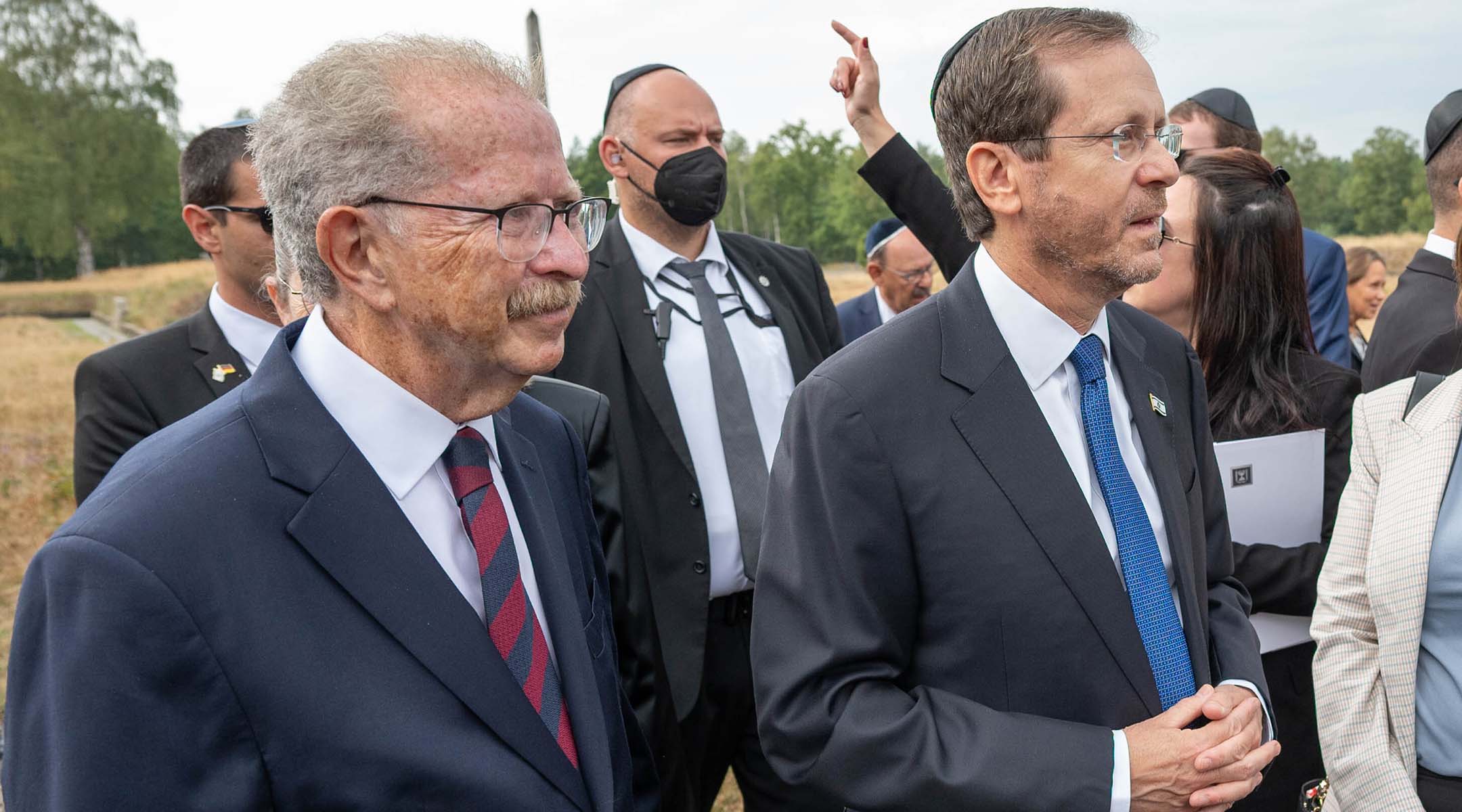At Bergen-Belsen, an activist born in DP camp commemorate loss and life
Menachem Rosensaft, associate executive vice president of the World Jewish Congress, doesn’t remember the camp. But he says it’s where his parents “returned to being human beings” after the war

Menachem Rosensaft, left, accompanies Israeli President Isaac Herzog, right, on a visit to the Bergen Belsen concentration camp, Sept. 6, 2022. (Shahar Azran/WJC)
(JTA) – One might not associate the term “concentration camp” with life. But that is exactly how Menachem Rosensaft views Bergen Belsen.
For it was here, in the displaced persons camp set up after World War II, that the longtime activist for Holocaust remembrance was born.
There, survivors — including Rosensaft’s parents, Josef Rosensaft and Hadassah Bimko — “returned to being human beings rather than brutalized victims, humans with hopes and aspirations, who were able to resume dreaming rather than endure nightmares,” said Rosensaft, 74, associate executive vice president and general counsel of the World Jewish Congress.
A longtime activist for Holocaust remembrance and for human rights across the board, Rosensaft accompanied Israeli President Isaac Herzog and German President Frank-Walter Steinmeier on their visit to the site in the northern German state of Lower Saxony on Tuesday.
The visit capped a three-day trip to Germany for Herzog, starting with ceremonies marking the 50th anniversary of the terrorist attack that left 11 Israeli athletes dead at the Munich Olympic Games. In Munich on Monday, Steinmeier apologized for Germany’s bungled rescue operation. Germany has now pledged $28 million in compensation to families of the victims and will open a joint inquiry with Israel into the course of events of 1972.
At the site of the former concentration camp on Tuesday, Steinmeier and Herzog were joined by several survivors, local students and a handful of people who, like Rosensaft, were born there after the war.
Over the years, Rosensaft — who also chairs the advisory board of the Lower Saxony Memorials Foundation, which oversees such memorial sites as Bergen-Belsen — has revisited the site numerous times in an official and personal capacity, usually on the anniversary of its liberation.
“Most importantly, I came here as my parents’ son,” he said.
From 1945 until 1950, his father headed both the Jewish Committee of the Bergen-Belsen Displaced Persons camp and the Central Committee of Liberated Jews in the British Zone of Germany. His mother, a dental surgeon, worked with the British Army medical personnel at the DP camp treating critically ill survivors. Only half a year after liberation, she testified in the first trial of Nazi war criminals. After coming to America, she championed the creation of the United States Holocaust Memorial Museum in Washington, D.C.
Herzog’s family history overlaps with Rosensaft’s: His late father, Chaim Herzog, was an officer with the British Army as it liberated Bergen-Belsen in April 1945. Chaim Herzog returned to the site in 1987, as Israel’s sixth president.
According to the U.S. Holocaust Memorial Museum, about 50,000 people died in Bergen Belsen, mostly of disease and starvation, between 1943 and 1945. Liberating soldiers found thousands of corpses. British authorities set up the DP camp in a nearby German military school barracks for more than 12,000 survivors. It closed in 1951, when Rosensaft was 2.
“I have no memory of the DP camp,” Rosensaft told the Jewish Telegraphic Agency. But he said his parents did tell him about it, “because that is something you can tell a child: This is what happened, this is what we did. Things of that nature.”
Only later did he learn “about the prequel,” he said. “And the advantage of that for a child, at least for me, is that I knew it did not end in hopelessness. There was a next chapter. And that next chapter did not exist at Auschwitz, at Treblinka,” two of the five extermination camps the Nazis established in occupied Poland.
The family ultimately settled in New York. A multi-talent, Rosensaft earned degrees in creative writing, history and law. He worked as an attorney for, among others, the Ronald S. Lauder Foundation, and he was appointed by President Bill Clinton to the U.S. Holocaust Memorial Council. He is a published poet and edited a 2015 collection of “Reflections of Children and Grandchildren of Holocaust Survivors.” His wife, Jean Bloch Rosensaft — also the child of survivors — curated the Hebrew Union College-Jewish Institute of Religion Museum exhibition, “Rebirth After the Holocaust: The Bergen-Belsen Displaced Persons Camp, 1945-1950” in 2002.
During Tuesday’s visit to the camp, Herzog was “retracing his father’s steps as part of the liberating army,” said Rosensaft. Herzog told the students and survivors “that this was a defining moment in his father’s life, and that it had made the biggest impression on him: When he came into Belsen shortly after the liberation, he was confronted with the evil that is possible,” Rosensaft recalled.
The two men also joined students in visiting the museum at the site, “the only Holocaust museum in the world that devotes fully one third of its exhibition space to the post war DP camp and all that was accomplished there,” Rosensaft said. Survivors “began new lives, new families,” he added. “It demonstrates what the erstwhile victims were capable of, the moment the yoke of slavery, oppression and annihilation was lifted from them.”
Rosensaft said he hoped the visit would encourage young Israelis and Germans “not just to mourn the dead but to recognize and learn from the resilience and boundless human potential demonstrated by the survivors.”
This article originally appeared on JTA.org.













